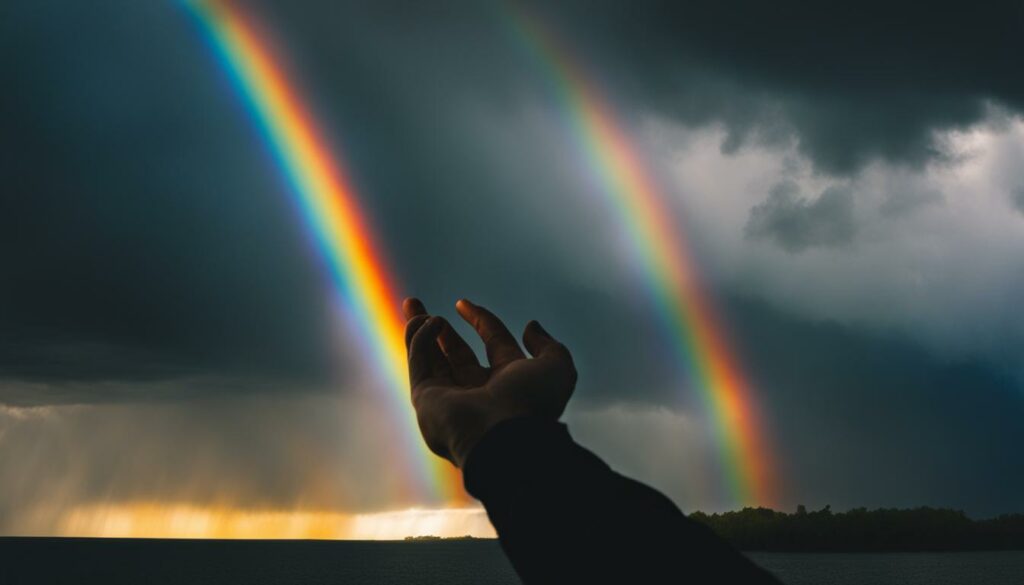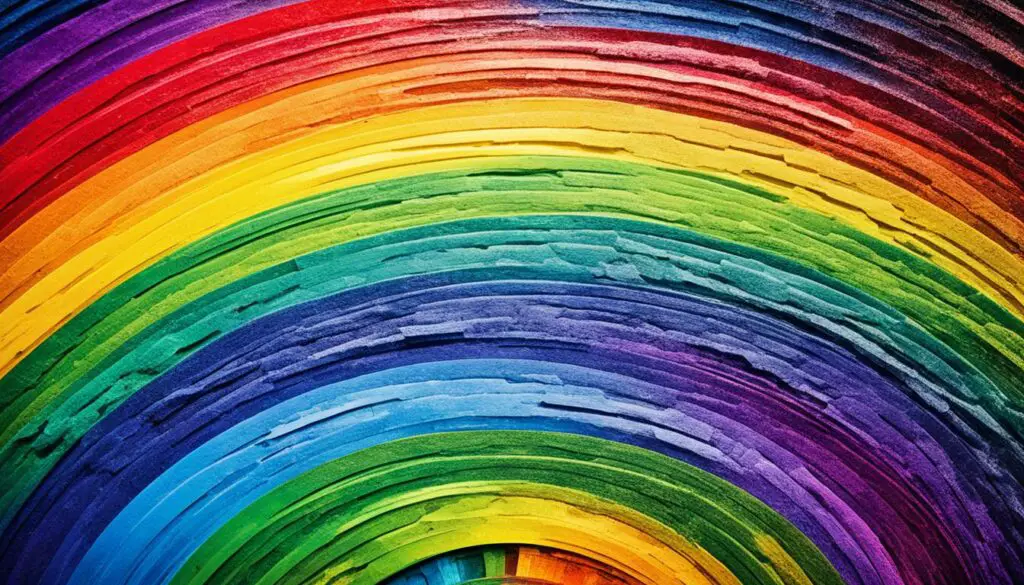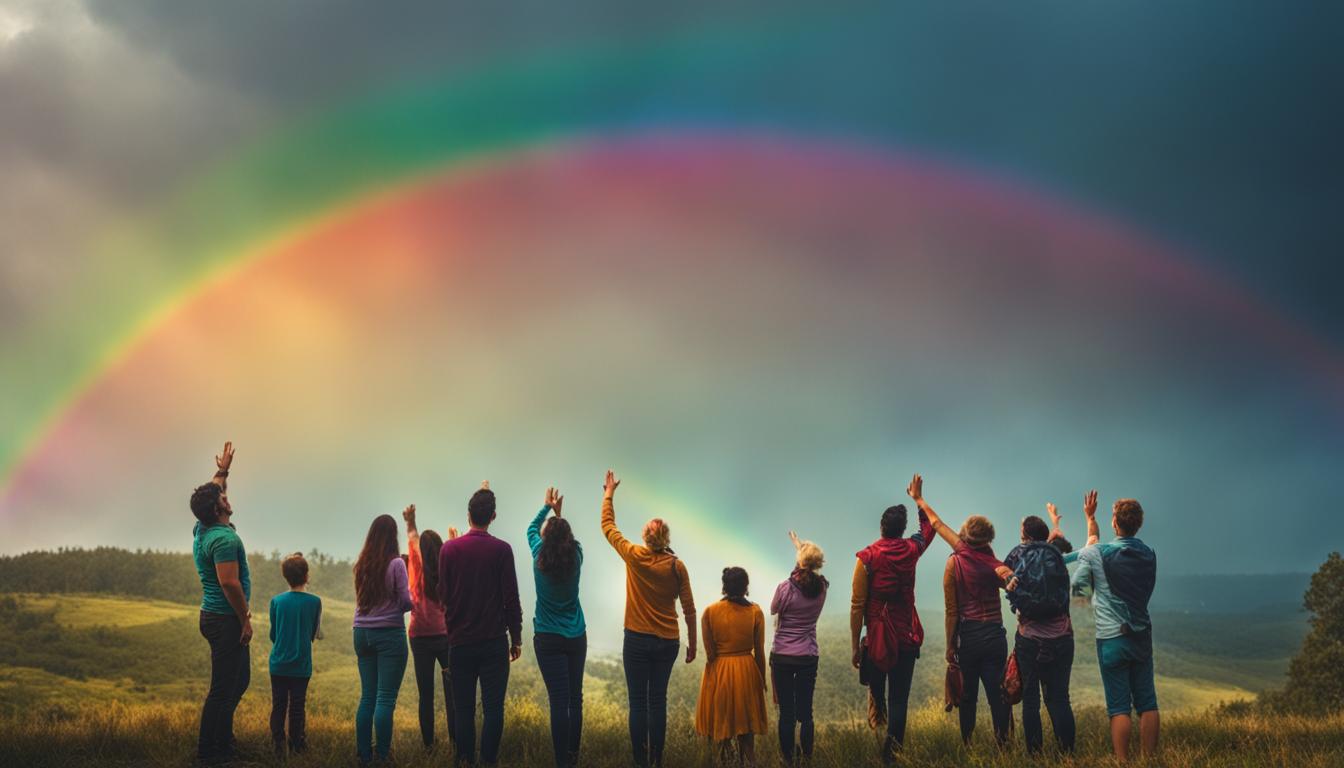Originally posted on January 24, 2024 @ 8:13 am
Growing up, many of us were taught that pointing at a rainbow is bad luck. This belief has been passed down through generations and is rooted in various cultures and traditions. But is there any truth to this superstition? Let’s explore the origins of this belief and examine the different myths and beliefs surrounding pointing at rainbows.
Key Takeaways:
- The belief that pointing at a rainbow is bad luck is ingrained in various cultures and traditions.
- Different cultures have their own myths and superstitions surrounding pointing at rainbows.
- In some cultures, the consequences of pointing at a rainbow are believed to include physical afflictions.
- The belief in the rainbow taboo is a globally recognized phenomenon that has persisted across time and borders.
- As societies modernize, beliefs surrounding the rainbow taboo are gradually diminishing.
The Navajo Culture and the Rainbow Taboo

In the Navajo culture, there exists a deep-rooted belief that pointing at a rainbow brings about bad luck and negative consequences. The Navajo people, known for their strong connection to nature, view rainbows as spiritual beings and hold them in high regard. Pointing at a rainbow is seen as an act of disrespect towards these divine entities.
This traditional belief has been passed down through generations and is an integral part of Navajo folklore. The Navajo people hold great reverence for the natural world and believe that disrupting the harmony of nature, such as by pointing at a rainbow, can result in disharmony and bring about undesirable outcomes.
This taboo has its origins in the cultural values and spiritual practices of the Navajo people. It is believed that by pointing at a rainbow, one is disrupting the balance and order of the natural world, inviting negative energies and disrupting the spiritual connection between humans and nature.
“In the Navajo culture, rainbows are seen as holy and living things. Pointing at a rainbow is like pointing at a part of the divine. It is considered disrespectful and brings bad luck.” – Traditional Navajo Elder
The belief in the bad luck associated with pointing at rainbows is deeply ingrained in Navajo traditions and continues to be upheld by many today. This cultural taboo serves as a reminder to show respect for the natural world and the spiritual significance attributed to rainbows in Navajo culture.
To gain a deeper understanding of the Navajo culture and their beliefs surrounding rainbows, let’s take a look at the following table that highlights key aspects of their traditional beliefs:
| Navajo Culture and Rainbow Pointing | Beliefs and Practices |
|---|---|
| View of Rainbows | Rainbows are seen as spiritual beings and are highly revered. |
| Consequences of Pointing | Pointing at a rainbow is believed to bring bad luck and negative outcomes. |
| Passing Down of Beliefs | The belief in the rainbow taboo is passed down through generations and is an integral part of Navajo folklore. |
| Respect for Nature | Pointing at a rainbow is seen as an act of disrespect towards the natural world and disrupts the harmony of nature. |
The cultural beliefs and practices of the Navajo people offer valuable insights into the significance they attribute to rainbows and their deep-rooted connection to the natural world. This appreciation for nature and spiritual beliefs surrounding rainbows continues to shape the Navajo culture and its traditions.
Myths and Superstitions About Pointing at Rainbows

Different cultures and traditions have their own myths and superstitions surrounding pointing at rainbows. These beliefs have been ingrained in society for centuries, passed down through generations, and have become an integral part of folklore and cultural beliefs.
Folklore and Consequences
In some cultures, it is believed that pointing at a rainbow can result in the growth of unwanted things, such as warts or moles. This superstition suggests that the act of pointing can bring about physical afflictions, and individuals are cautioned against engaging in such behavior.
“Pointing at a rainbow is believed to make warts grow on your fingers and hands. It’s a consequence that has been passed down from generation to generation, and it’s best not to tempt fate,” warns an old Scottish folk tale.
Furthermore, many cultures associate pointing at a rainbow with bad luck or negative events. It is believed that this act may bring about misfortune or invite negative energies into one’s life. The consequences attached to this superstition may vary across cultures, but they generally revolve around the idea that one should not disturb or disrespect the mystical beauty of a rainbow.
Cultural Beliefs and Explanations
These myths and superstitions surrounding rainbow pointing can be attributed to cultural beliefs and traditional interpretations of natural phenomena. In many societies, rainbows are seen as divine signs, magical bridges between the earthly and spiritual realms. Pointing at a rainbow is viewed as an act of aggression towards a sacred being, which goes against cultural norms of respect and reverence.
“Rainbows are spirits that bring messages from the heavens. If you point at one, you are showing disrespect and may invite calamities upon yourself,” explains an Aboriginal elder from Australia.
The enduring belief that pointing in general is aggressive behavior further reinforces the taboo surrounding rainbows. Pointing is often associated with scolding, belittling, or even cursing in certain cultures. Therefore, directing this gesture towards a rainbow is seen as an offensive act, warranting potential consequences.
Examples of Folklore
Let’s explore some prominent examples of folklore and cultural beliefs about pointing at rainbows:
- In Irish folklore, pointing at a rainbow is believed to cause it to disappear, bringing bad luck and disappointment to the individual.
- In Greek mythology, it is believed that Iris, the personification of the rainbow, is a messenger of the gods. Pointing at a rainbow is thought to insult the gods and may result in divine punishment.
- Native American tribes, such as the Lakota Sioux, have legends that caution against pointing at rainbows to ensure harmony with the spirits and the natural world.
The Cultural Diversity of Rainbow Pointing Beliefs
These myths and superstitions surrounding pointing at rainbows reflect the rich cultural diversity and beliefs found across the globe. Each society has its own unique interpretations and consequences associated with this act.
Let’s take a closer look at some of the different cultural beliefs about pointing at rainbows:
| Culture | Belief | Consequences |
|---|---|---|
| Scottish | Pointing at a rainbow causes warts to grow on fingers and hands. | Warts and potential bad luck. |
| Chinese | Pointing at a rainbow is believed to disturb the gods and may result in misfortune or bad luck. | Bad luck and displeasure of the gods. |
| Hawaiian | Pointing at a rainbow is disrespectful to the gods and can bring heavy rains and storms. | Increased rainfall and natural disasters. |
As demonstrated by these examples, the consequences of pointing at rainbows vary widely, highlighting the diverse beliefs and traditions surrounding this act.
Intriguing Cultural Beliefs
The myths and superstitions surrounding pointing at rainbows provide a fascinating insight into the cultural beliefs and practices of different societies. These beliefs serve as a reminder of the human tendency to attribute meaning and create narratives around natural phenomena.
The image above captures the intrigue and wonder associated with rainbows, conveying the cultural significance and the captivating beauty that has inspired numerous beliefs and stories throughout history.
The Global Phenomenon of the Rainbow Taboo

The belief that pointing at a rainbow is bad luck is not limited to one culture or region. Research conducted by linguistics professor Robert Blust has documented this belief in 124 different cultures around the world. The taboo is present in various forms and comes with specific consequences for violating it. It is a globally recognized phenomenon that has persisted across time and borders.
The traditional beliefs about rainbow pointing are deeply ingrained in diverse cultures globally. The fear of bad luck or negative consequences associated with pointing at rainbows transcends geographical boundaries and extends across continents.
Wide-ranging Taboos and Beliefs
Each culture has its own unique interpretations and taboos surrounding pointing at rainbows, but the underlying belief is consistent – pointing at a rainbow can bring about undesirable outcomes.
For example, in Irish folklore, it is believed that pointing at a rainbow will cause one’s finger to rot. In Scandinavian culture, it is said that pointing at a rainbow will bring about eternal blindness. These vivid and cautionary tales underline the deep-rooted beliefs surrounding rainbows.
The specific consequences associated with pointing at rainbows vary across cultures but often include physical afflictions, the growth of unwanted things, or inviting bad luck and misfortune.
The Influence of Traditions and Cultural Norms
The widespread taboo surrounding pointing at rainbows can be attributed to the influence of traditions and cultural norms. Rainbows have been considered sacred in many cultures, often associated with divine or spiritual phenomena. Thus, pointing at a rainbow is seen as acting aggressively towards a sacred being, a violation of cultural norms and a sign of disrespect.
Additionally, pointing itself is often viewed as aggressive behavior in certain cultures. Combining this perception with the sacredness attributed to rainbows strengthens the belief in the taboo and the consequences associated with violating it.
Diverse Perspectives, Shared Belief
While the specific details and consequences of the rainbow taboo may differ across cultures, the belief in its existence remains a common thread. People from various parts of the world, despite their cultural differences, share a deep-rooted respect for rainbows and the belief that pointing at them can bring about negative outcomes.
Table: Cultures with Beliefs about Pointing at Rainbows:
| Culture | Belief |
|---|---|
| Ireland | Pointing at a rainbow causes finger rot |
| Scandinavia | Pointing at a rainbow results in eternal blindness |
| Navajo | Pointing at a rainbow is a bad omen |
| Thailand | Pointing at a rainbow invites bad luck |
These examples illustrate how diverse cultures share similar beliefs when it comes to pointing at rainbows, emphasizing the global nature of the phenomenon.
The Origins and Explanations of the Rainbow Taboo

The belief that pointing at a rainbow is bad luck has its origins in a combination of cultural and traditional beliefs. Rainbows have long been considered sacred and associated with the divine in many cultures. This association with the divine instills a sense of reverence for rainbows and deems them deserving of respect.
Pointing at a rainbow is seen as acting aggressively towards this sacred being, going against cultural norms of respect and reverence. It is viewed as a violation of the sanctity and beauty of the rainbow, possibly resulting in negative consequences for the offender.
In addition to the sacred nature of rainbows, the act of pointing itself is often viewed as aggressive behavior. Pointing is traditionally associated with drawing attention, often with a negative connotation. This perception further reinforces the taboo surrounding pointing at rainbows.
The origins and explanations of the rainbow taboo can be summarized as follows:
- Rainbows are considered sacred and associated with the divine.
- Pointing at a rainbow is seen as acting aggressively towards a sacred being.
- Pointing, in general, is often viewed as aggressive behavior.
“The combination of the sacred nature of rainbows and the perception of pointing as aggressive behavior has led to the establishment and perpetuation of the rainbow taboo in various cultures.”
It is important to note that the origins and explanations of the rainbow taboo may vary across cultures and traditions, but the underlying themes of reverence, respect, and the aversion to aggressive behavior remain consistent.
| Origins of Rainbow Taboo | Reasons for Rainbow Taboo | Traditional Beliefs about Rainbows |
|---|---|---|
| Sacred nature of rainbows | Perceived aggression towards a sacred being | Association of rainbows with the divine |
| Viewing pointing as aggressive behavior | Violation of cultural norms of respect and reverence | Taboo surrounding aggressive behavior and disrespect |
The origins and explanations of the rainbow taboo provide insight into the cultural significance and perceptions surrounding rainbows. Understanding these beliefs helps to shed light on the reasons behind the taboo and the traditional values that shape our interactions with this natural phenomenon.
Specific Consequences for Pointing at Rainbows

Different cultures hold specific beliefs about the consequences of pointing at a rainbow. These beliefs often associate physical afflictions with the act of pointing, revealing the deep-rooted fear and taboo surrounding this action. While these consequences may vary across cultures, they consistently highlight the perceived dangers of violating the rainbow taboo.
In some cultures, pointing at a rainbow is believed to result in physical manifestations of afflictions. For instance, certain beliefs suggest that the fingers of those who point at a rainbow may become bent or paralyzed. Others associate pointing with the development of warts or ulcers.
Interestingly, these consequences are not always limited to the person who does the pointing. In some cultures, it is believed that the ill effects extend to the person’s mother as well. This demonstrates the depth of conviction in these beliefs and the shared responsibility placed upon individuals who engage in the act of pointing at rainbows.
“To point at a rainbow is to invite misfortune upon oneself and those close to them.”
The specific consequences associated with pointing at rainbows offer valuable insights into the cultural significance and power of this taboo. The physical nature of the consequences underscores the perceived direct harm that can be inflicted upon those who violate this belief. These beliefs serve to deter individuals from engaging in the act of pointing, preserving the cultural reverence and respect for rainbows.
Consequences of Pointing at Rainbows Across Different Cultures
| Culture | Consequences |
|---|---|
| Navajo | Bent or paralyzed fingers |
| Greek | Development of warts |
| Japanese | Ulcers |
| Mayan | Afflictions on the person and their mother |
The table above provides a glimpse into the diverse range of consequences associated with pointing at rainbows across different cultures. It highlights the intriguing variations in beliefs, reflecting the unique cultural perspectives and interpretations of this taboo.
The image above visually captures the mystique and allure of rainbows, reinforcing the significance of avoiding their pointed reference.
Evolution and Persistence of the Rainbow Taboo

The belief that pointing at a rainbow is bad luck has withstood the test of time, evolving and persisting across different cultures and generations. Throughout history, various ethnographies have documented the presence of this taboo, indicating its long-standing existence in human beliefs and traditions.
The rainbow taboo has been passed down from one generation to another, adapting and mutating as it spreads across different cultures. This evolution can be attributed to a combination of factors, including psychological triggers that amplify its allure.
“The rainbow taboo has become deeply ingrained in the collective consciousness of societies worldwide. It resonates with our psychology, creating a sense of danger and awe that is difficult to ignore,” explains Dr. Sofia Martinez, a cultural anthropologist.
The taboo’s persistence can be understood through the lens of psychological factors such as the allure of danger and the nature of human beliefs. It taps into our innate aversion to perceived threats and our tendency to attach significance to rituals and superstitions.
By examining the historical beliefs about rainbows, we gain insight into how this taboo developed and why it continues to hold sway in many cultures.
Contemporary Views on the Rainbow Taboo

As societies modernize and superstitions fade, there is a gradual shift in beliefs surrounding the rainbow taboo. What was once a deeply ingrained belief in many cultures is now fading away. One example of this shifting perspective can be seen in Thailand, where the taboo is still acknowledged but more as a topic of curiosity or amusement rather than strict adherence.
“Why would pointing at a rainbow bring bad luck? It seems silly to me,” says Supaporn, a Thai resident. “I enjoy the beauty of rainbows and I don’t see any harm in pointing at them. It’s just a superstitious belief.”
Discussions surrounding the rainbow taboo often center around the perceived silliness of the belief. People are questioning the rationale behind such taboos and starting to view them as baseless superstitions. This shift in mindset is contributing to the fading of the once ubiquitous belief in many parts of the world.
While the fading of the rainbow taboo beliefs is a positive sign of modernization, it’s important to note that cultural beliefs and traditions still hold significance for many individuals. However, as societies continue to evolve, these beliefs may continue to diminish in prominence.
In summary, as societies modernize and superstitions fade, there is a noticeable shift in beliefs surrounding the rainbow taboo. The once widely-held belief is gradually fading out, and people are questioning the rationale behind such taboos. While cultural beliefs and traditions still exist for many, the overall trend indicates a diminishing prominence of the rainbow taboo in contemporary society.
The Universal Fascination with Rainbows
Despite the superstitions surrounding pointing at rainbows, these natural phenomena continue to hold a profound fascination and captivate people across the globe. Rainbows have a unique ability to both physically exist and elude our grasp, defying our understanding of physics and sparking wonder and awe in our hearts.
The breathtaking beauty of rainbows evokes a fundamental human response, prompting us to pause, admire, and appreciate their vibrant colors. From the delicate pastels to the bold and vivid hues, rainbows exhibit a mesmerizing spectrum of light that captivates our visual senses and evokes a sense of joy and tranquility.
“Rainbows are the poetry of nature, painting the sky with a palette of enchanting colors.”
Beyond their aesthetic allure, rainbows hold significant cultural significance. Across different civilizations and throughout history, rainbows have been embraced as powerful symbols of beauty, hope, and transformation. They have been immortalized in art, literature, and mythology, representing the bridge between heaven and earth, and serving as a reminder of the interconnectedness of all things.
The cultural significance of rainbows transcends mere superstitions, permeating deep into the fabric of our collective consciousness. These awe-inspiring natural phenomena have the power to unite and inspire, igniting a sense of wonder and creativity in all who behold them.
| Fascination with Rainbows | Admiration of Rainbows | Cultural Significance of Rainbows |
|---|---|---|
| ✨ Rainbows captivate people worldwide with their ethereal beauty. | ✨ The vibrant colors elicit admiration and delight. | ✨ Rainbows hold profound cultural symbolism and represent hope and interconnectedness. |
| ✨ The mysterious nature of rainbows sparks curiosity and wonder. | ✨ They inspire awe and a sense of harmony with nature. | ✨ Rainbows have been celebrated in various art forms and narratives throughout history. |
| ✨ Rainbows evoke joy and a childlike sense of wonder. | ✨ Their ephemeral presence reminds us to cherish fleeting moments of beauty. | ✨ They serve as a universal symbol of optimism and resilience. |
Through their enchanting colors and ethereal presence, rainbows continue to captivate the hearts and minds of people across cultures and generations. It is a testament to the enduring power of nature’s wonders and our innate fascination with the beauty that surrounds us.
Conclusion
In conclusion, the belief that it is bad luck to point at a rainbow is deeply ingrained in various cultures and traditions around the world. While the specific consequences may vary, the taboo surrounding rainbows stems from a combination of reverence for the sacred and the view that pointing is aggressive behavior.
As societies evolve and superstitions fade, beliefs about the rainbow taboo are gradually diminishing. However, the fascination and admiration for rainbows remain universal, reminding us of the beauty and wonder of the natural world.
Despite the superstitions, we can still appreciate the captivating colors and awe-inspiring sight of rainbows. As we move forward, let us remember that rainbows are not just a symbol of luck or bad omens, but a testament to the incredible diversity and beauty of our planet.
FAQ
Where does the belief that pointing at a rainbow is bad luck come from?
The belief stems from various cultures and traditions that view rainbows as sacred beings and consider pointing at them as disrespectful and aggressive behavior.
Are there specific consequences for pointing at a rainbow?
Different cultures have different beliefs regarding consequences, which may include physical afflictions such as bent or paralyzed fingers, warts, or ulcers.
Is the rainbow taboo present in other cultures as well?
Yes, the rainbow taboo has been documented in 124 different cultures around the world, indicating its global presence and significance.
Why is pointing at a rainbow considered aggressive?
Pointing in general is often seen as aggressive behavior, and when directed at a rainbow, it is viewed as acting aggressively towards a sacred being.
Are beliefs about the rainbow taboo fading in modern societies?
Yes, as societies modernize and superstitions fade, beliefs surrounding the rainbow taboo are gradually diminishing in many parts of the world.
Why are rainbows so fascinating to people?
Rainbows captivate people worldwide due to their vibrant colors and the fundamental human response of wonder and awe. They are universally seen as symbols of beauty and hope.
